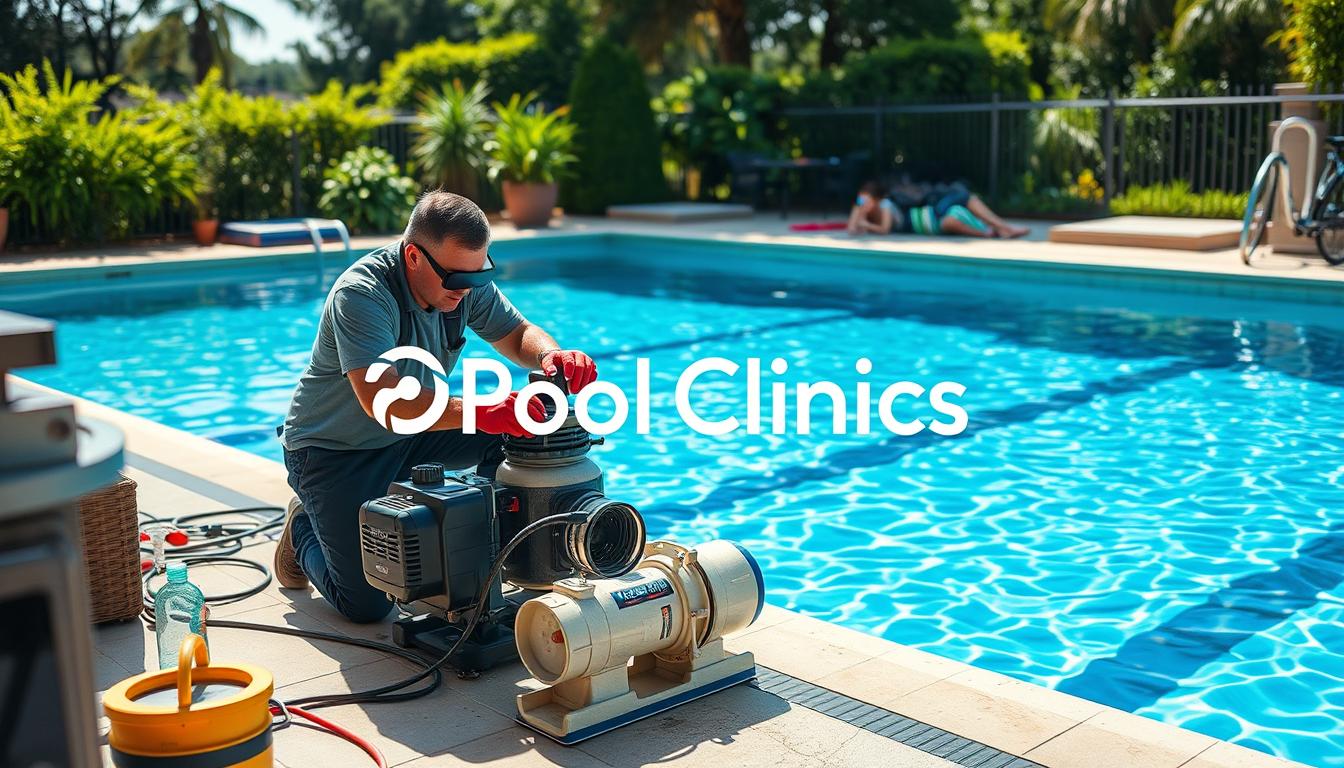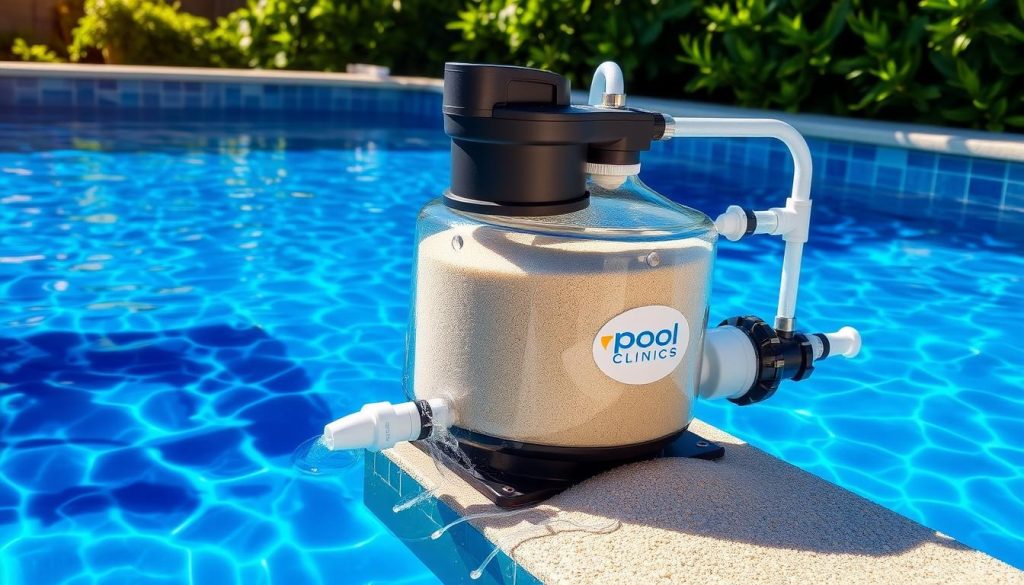
Clean, healthy pool water is crucial for safe swimming. Many ask if chlorine should be used with sand filters. Let’s explore how sand filters and chlorine work together to keep your pool pristine.
Sand filters effectively trap tiny particles, down to 20-30 microns. They’re popular for their simplicity and durability. Proper care ensures optimal performance and longevity.
We’ll discuss the filtration process and compatibility with various pools. Understanding chlorine levels is key to maintaining good pool chemistry and sanitation.
Key Takeaways
- Sand filters trap particles as small as 20-30 microns and require proper maintenance for optimal performance.
- Chlorine works in conjunction with sand filters to maintain clean and healthy pool water.
- Regular backwashing and replacing sand every 3-5 years are essential for effective sand pool filter maintenance.
- Maintaining proper pool chlorine levels is crucial for optimal pool sanitation and pool water chemistry.
- Sand filters are compatible with various pool types and offer a simple, durable, and effective filtration solution.
How Sand Filters Work in Your Pool
Sand filters effectively clean pool water. They use fine sand to remove contaminants, ensuring safe swimming. Let’s explore how they work and their compatibility with various pools.
The Filtration Process
Sand filters use a simple yet effective process. Water enters the top and passes through layers of sand with varying coarseness.
The sharp edges of sand grains capture debris, dirt, and other particles. This prevents them from re-entering the pool.

Filtered water exits through the bottom and returns to the pool. The pool pump keeps circulating water through the filter for optimal quality.
Compatibility with Various Pool Types
Sand filters are versatile and work with many pool types. They’re effective for above-ground, in-ground, indoor, and outdoor pools.
These filters also work well with hot tubs, salt water pools, and swim-spas. This adaptability makes them popular among pool owners.
| Pool Type | Compatibility |
|---|---|
| Above-ground pools | Yes |
| In-ground pools | Yes |
| Indoor and outdoor hot tubs | Yes |
| Salt water pools | Yes |
| Swim-spas | Yes |
Sand filters are easy to integrate into various pool setups. They require low maintenance, are easy to operate, and cost-effective.
Sand filters have been a go-to choice for pool owners due to their impressive ability to maintain crystal-clear water while being compatible with a variety of pool types.
Understanding sand filters helps you choose the right system. Regular pool filter cleaning and backwashing ensure excellent water quality.
Sand filters work well for both chlorine and salt water pools. With proper care, they’ll keep your pool clean for years.
Maintaining Your Sand Filter for Optimal Performance
Regular sand filter maintenance keeps pool water clean and clear. It traps debris and prevents algae blooms. Monitoring the pressure gauge helps determine when to perform routine tasks.
Backwashing Your Sand Filter
Backwashing reverses water flow to flush out accumulated dirt. Do this when the pressure gauge reads 8-10 PSI above normal. This process restores healthy water circulation and maintains optimal filtration efficiency.
Here’s how to backwash your sand filter:
- Turn off the pump and set the multiport valve to the “backwash” position.
- Turn on the pump and let it run for 2-3 minutes or until the water in the sight glass appears clear.
- Turn off the pump and set the multiport valve to the “rinse” position.
- Turn on the pump and let it run for 30-60 seconds to settle the sand bed.
- Turn off the pump and set the multiport valve back to the “filter” position.
- Turn on the pump and resume normal operation.
Replacing the Sand in Your Filter
Replace the sand every 5 to 7 years, depending on usage. Signs it’s time include high pressure readings and cloudy water. Visible algae growth despite regular backwashing also indicates a need for replacement.
- Turn off the pump and drain the water from the filter tank.
- Remove the top of the tank and scoop out the old sand.
- Inspect the laterals at the bottom of the tank for damage and replace if necessary.
- Fill the tank halfway with water to protect the laterals during sand loading.
- Add the new sand, ensuring it’s specifically designed for pool filters.
- Replace the top of the tank and run the pump for a few minutes to purge air from the system.
Advantages and Disadvantages of Sand Filters
Sand filters offer benefits for pool owners, but they also have some drawbacks. Consider these factors when choosing a filter system.
| Advantages | Disadvantages |
|---|---|
| Low maintenance requirements | May require more frequent backwashing than other filter types |
| Easy to operate | Not as effective at filtering small particles (down to 20 microns) |
| Affordable upfront cost | Sand needs to be replaced every 5-7 years |
| Durable and long-lasting | Requires more space for installation |
Regular maintenance is the key to ensuring our sand filter performs at its best, keeping our pool water clean, clear, and inviting for years to come.
do you use chlorine with a sand filter
Sand filters alone can’t ensure a safe swimming environment. They remove dirt and debris but can’t eliminate harmful bacteria. Chlorine is essential for pool sanitation.
Sand filters and chlorine work together to clean your pool. Chlorine kills microorganisms, while sand filters remove physical contaminants. This combo keeps your pool water safe and clear.
The Importance of Maintaining Proper Chlorine Levels
Proper chlorine levels keep pool water sanitized and safe. Chlorine disinfects by burning out organic matter that supports harmful microorganisms. Regular monitoring prevents waterborne illnesses and ensures a healthy swimming environment.
Here are the recommended chlorine levels for residential pools:
| Chlorine Type | Ideal Range (ppm) |
|---|---|
| Free Chlorine | 1.0 – 3.0 |
| Combined Chlorine | 0.0 – 0.2 |
| Total Chlorine | 1.0 – 3.0 |
Test your pool water regularly with a reliable kit. Adjust chlorine levels as needed. This proactive approach maintains a clear, inviting pool throughout the season.
How Sand Filters and Chlorine Work Together
Chlorine eliminates microorganisms and oxidizes organic matter, forming larger particles. The sand filter then traps these particles as water circulates through the system. This process removes contaminants effectively.
Effective pool chlorination and regular sand filter maintenance create a powerful duo. They keep your pool water clean, clear, and safe for everyone.
To optimize your sand filter and chlorine system:
- Backwash your sand filter regularly to remove trapped contaminants and maintain optimal water flow.
- Replace the sand in your filter every 5-7 years to ensure maximum filtration efficiency.
- Monitor and adjust chlorine levels consistently to maintain proper sanitation.
- Run your pool pump and filter for at least 8-12 hours per day to ensure adequate water circulation and filtration.
Follow these best practices for pool chemistry and water filtration. You’ll enjoy a sparkling clean pool all season long. Your family and friends will love swimming in your well-maintained pool.
Conclusion
Sand filters and chlorine are vital for effective pool maintenance. They work together to ensure clean water and a healthy swimming environment. Sand filters capture particles as small as 20-30 microns, making them popular in competition pools worldwide.
Regular backwashing of sand filters removes contaminants and restores filter pressure. The Orenda Filter Purge™ offers a cost-effective solution for removing organic contamination. Maintaining proper chlorine levels between 0.3 and 0.5 mg/L keeps pool water sanitized and safe.
Chlorine has many benefits, including high active content and full dissolution. It also contains stabilizers that reduce loss due to sunlight. Other treatments like algaecides and flocculants help maintain balanced water within the ideal pH range.
Pool owners should consider filtration finesse and ease of maintenance when choosing a system. Sand changes are rarely needed, but regular purging every few years prevents channeling. Understanding filtration and sanitation is key to maintaining clean pool water.
By diligently carrying out necessary tasks, pool owners can ensure a pleasant swimming experience. This commitment to maintenance creates a healthy and enjoyable environment for all swimmers.







